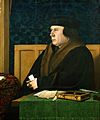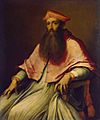English Reformation facts for kids
The English Reformation was a big change in England's history, especially for its Christian churches. It was part of a larger movement called the Protestant Reformation, where many churches in Europe decided to break away from the Roman Catholic Church in Rome. Each country did this in its own way. Before this, the Roman Catholic Church had a lot of power.
King Henry VIII of England decided to separate from the Roman Catholic Church. In 1534, he passed laws called the Acts of Supremacy. These laws made him the head of the English church instead of the Pope. This was the start of the Church of England. Henry's friend, Thomas Cranmer, became his Archbishop of Canterbury. For many years, the Church of England was quite similar to the Catholic Church. The main difference was that the King ruled it, not the Pope. This was different from other parts of Europe, where reformers wanted big changes right away.
Contents
Why the English Church Changed
There were a few main reasons why the English Reformation happened.
King Henry VIII's Divorce
One big reason was that King Henry VIII wanted to divorce his wife, Catherine of Aragon. He wanted to marry someone else to have a son who could become king. The Pope would not let him get a divorce. This made Henry very angry and led him to break away from the Pope's authority.
Gaining Wealth and Power
Another reason was that King Henry wanted the wealth and power of the Church in England. He got this by closing down many monasteries and convents. This was called the dissolution of the monasteries. When these places closed, the King took their land and money. This made him much richer and more powerful.
Reformation in Scotland
The Protestant Reformation in Scotland was a bit different from England's. It was more like the Reformation happening in other parts of Europe. In Scotland, the changes were more strongly influenced by the ideas of Martin Luther and John Calvin. These religious leaders wanted bigger changes to church beliefs and practices.
Images for kids
-
King Henry VIII of England by Hans Holbein the Younger. Thyssen-Bornemisza Museum, Madrid.
-
Thomas Cromwell, 1st Earl of Essex (c. 1485–1540), Henry VIII's chief minister 1532–40.
-
Thomas More, with John Fisher the leader of political resistance against the break with Rome. Both were executed in 1535.
-
St Paul's Cross (in the lower left corner of the painting) was a prominent preaching cross on the grounds of Old St Paul's Cathedral.
-
Remains of Finchale Priory, a Benedictine monastery near Durham that was closed in 1535
-
The chapter house of Forde Abbey, a Cistercian monastery closed in 1539 and converted into a country house
-
The 14th-century Chantry Chapel of St Mary the Virgin in Wakefield, West Yorkshire. Chantries were endowments that paid priests to say masses for the dead to lessen their time in purgatory.
-
This statue in the Lady Chapel of Ely Cathedral was vandalized during the Reformation.
-
Edward VI and the Pope: An Allegory of the Reformation. This Elizabethan work of propaganda depicts the handing over of power from Henry VIII, who lies dying in bed, to Edward VI, seated beneath a cloth of state with a slumping pope at his feet. In the top right of the picture is an image of men pulling down and smashing idols. At Edward's side are his uncle the Lord Protector Edward Seymour and members of the Privy Council.
-
Thomas Cranmer (1489–1556), Henry VIII's Archbishop of Canterbury and editor and co-author of the first and second Books of Common Prayer.
-
Cardinal Reginald Pole presided over the English Church's reconciliation with Rome
See also
 In Spanish: Reforma anglicana para niños
In Spanish: Reforma anglicana para niños




















